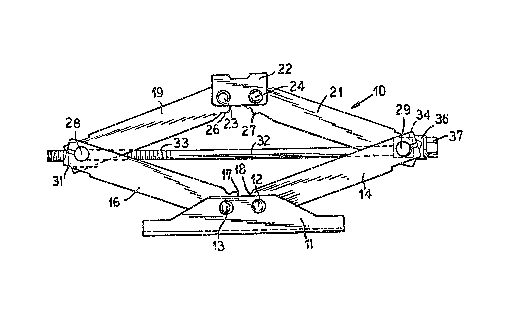Une partie des informations de ce site Web a été fournie par des sources externes. Le gouvernement du Canada n'assume aucune responsabilité concernant la précision, l'actualité ou la fiabilité des informations fournies par les sources externes. Les utilisateurs qui désirent employer cette information devraient consulter directement la source des informations. Le contenu fourni par les sources externes n'est pas assujetti aux exigences sur les langues officielles, la protection des renseignements personnels et l'accessibilité.
L'apparition de différences dans le texte et l'image des Revendications et de l'Abrégé dépend du moment auquel le document est publié. Les textes des Revendications et de l'Abrégé sont affichés :
| (12) Brevet: | (11) CA 2098856 |
|---|---|
| (54) Titre français: | OUTIL DE LEVAGE A EXTREMITE LIBRE AMELIOREE |
| (54) Titre anglais: | IMPROVED OPEN END CONSTRUCTION FOR JACK |
| Statut: | Périmé et au-delà du délai pour l’annulation |
| (51) Classification internationale des brevets (CIB): |
|
|---|---|
| (72) Inventeurs : |
|
| (73) Titulaires : |
|
| (71) Demandeurs : |
|
| (74) Agent: | CASSAN MACLEAN |
| (74) Co-agent: | |
| (45) Délivré: | 1999-01-19 |
| (22) Date de dépôt: | 1993-06-21 |
| (41) Mise à la disponibilité du public: | 1994-09-18 |
| Requête d'examen: | 1995-11-29 |
| Licence disponible: | S.O. |
| Cédé au domaine public: | S.O. |
| (25) Langue des documents déposés: | Anglais |
| Traité de coopération en matière de brevets (PCT): | Non |
|---|
| (30) Données de priorité de la demande: | ||||||
|---|---|---|---|---|---|---|
|
Une amélioration est apportée à une terminaison ouverte pour un vérin. Cette terminaison est constituée par des languettes orientées à angle droit par rapport aux côtés des canaux, permettant d'insérer une cheville dans cette terminaison. la suite de cette opération, on replie les languettes de façon qu'elles soient orientées dans le plan des côtés des canaux, de sorte que la cheville soit immobilisée dans la terminaison. On peut également monter des anneaux partiels aux ouvertures des terminaisons des canaux afin de fournir des surfaces d'appui aux chevilles.
An improved open end construction for jacks which
provides for tabs which extend at right angles to the side
surfaces of the channel members so as to allow pivot pins to
be received in the open ends after which the tabs are bent so
that they lie in the plane of the side surfaces of the channel
members so as to lock the pivot pin in the ends of the channel
assembly. Also, partial flanges can be formed about the
openings in the ends of the channel members so as to provide
bearing surfaces for the pivot pins.
Note : Les revendications sont présentées dans la langue officielle dans laquelle elles ont été soumises.
Note : Les descriptions sont présentées dans la langue officielle dans laquelle elles ont été soumises.

2024-08-01 : Dans le cadre de la transition vers les Brevets de nouvelle génération (BNG), la base de données sur les brevets canadiens (BDBC) contient désormais un Historique d'événement plus détaillé, qui reproduit le Journal des événements de notre nouvelle solution interne.
Veuillez noter que les événements débutant par « Inactive : » se réfèrent à des événements qui ne sont plus utilisés dans notre nouvelle solution interne.
Pour une meilleure compréhension de l'état de la demande ou brevet qui figure sur cette page, la rubrique Mise en garde , et les descriptions de Brevet , Historique d'événement , Taxes périodiques et Historique des paiements devraient être consultées.
| Description | Date |
|---|---|
| Inactive : CIB de MCD | 2006-03-11 |
| Le délai pour l'annulation est expiré | 2002-06-21 |
| Lettre envoyée | 2001-06-21 |
| Accordé par délivrance | 1999-01-19 |
| Inactive : Taxe finale reçue | 1998-10-05 |
| Préoctroi | 1998-10-05 |
| Un avis d'acceptation est envoyé | 1998-08-27 |
| Un avis d'acceptation est envoyé | 1998-08-27 |
| Lettre envoyée | 1998-08-27 |
| Inactive : Renseign. sur l'état - Complets dès date d'ent. journ. | 1998-08-20 |
| Inactive : Dem. traitée sur TS dès date d'ent. journal | 1998-08-20 |
| Inactive : Approuvée aux fins d'acceptation (AFA) | 1998-06-25 |
| Exigences pour une requête d'examen - jugée conforme | 1995-11-29 |
| Toutes les exigences pour l'examen - jugée conforme | 1995-11-29 |
| Demande publiée (accessible au public) | 1994-09-18 |
Il n'y a pas d'historique d'abandonnement
Le dernier paiement a été reçu le 1998-06-02
Avis : Si le paiement en totalité n'a pas été reçu au plus tard à la date indiquée, une taxe supplémentaire peut être imposée, soit une des taxes suivantes :
Les taxes sur les brevets sont ajustées au 1er janvier de chaque année. Les montants ci-dessus sont les montants actuels s'ils sont reçus au plus tard le 31 décembre de l'année en cours.
Veuillez vous référer à la page web des
taxes sur les brevets
de l'OPIC pour voir tous les montants actuels des taxes.
| Type de taxes | Anniversaire | Échéance | Date payée |
|---|---|---|---|
| TM (demande, 4e anniv.) - générale | 04 | 1997-06-23 | 1997-06-16 |
| TM (demande, 5e anniv.) - générale | 05 | 1998-06-22 | 1998-06-02 |
| Taxe finale - générale | 1998-10-05 | ||
| TM (brevet, 6e anniv.) - générale | 1999-06-21 | 1999-05-12 | |
| TM (brevet, 7e anniv.) - générale | 2000-06-21 | 2000-06-19 |
Les titulaires actuels et antérieures au dossier sont affichés en ordre alphabétique.
| Titulaires actuels au dossier |
|---|
| UNIVERSAL TOOL & STAMPING COMPANY, INC. |
| Titulaires antérieures au dossier |
|---|
| DARRYL L. ENGEL |
| JOHN R. SCOVILLE |